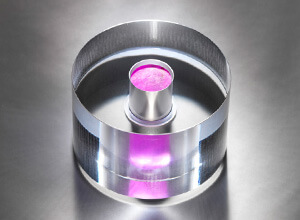Scientists from the National Physical Laboratory and Imperial College London have demonstrated, for the first time ever, a maser (a device for amplifying microwaves by radiation) in a solid state capable of operating at room temperature

Scientists from the National Physical Laboratory and the University of Imperial College London demonstrated, for the first time ever, a maser (a device for amplifying microwaves by radiation) in a solid state capable of operating at room temperature. This discovery paves the way for the widespread application of the mechanism in many fields.
MASER is an acronym that means "amplification of microwaves by forced emission of radiation". Devices based on this process were developed by scientists already fifty years ago, even before laser devices were invented. Instead of emitting a powerful beam of light, as in the case of a laser, the maser device emits a concentrated beam of microwaves.
Normal maser devices work by amplifying microwaves using crystals, such as ruby. At the same time, the technological effect of the maser was small and limited compared to the effect of the laser, since its operation requires extreme conditions that are difficult to obtain - either extremely low pressures, which are obtained with the help of vacuum chambers and powerful pumps, or freezing conditions at temperatures close to absolute zero (-273.1 degrees Celsius) which are obtained with the help of special cooling devices. In addition to this, sometimes it is also necessary to use the activation of powerful magnetic fields, a fact that requires the use of large magnets.
Now, the team of researchers from the National Physical Laboratory and the University of Imperial College London have demonstrated a maser within the device that operates in air and at room temperature without the need to activate any magnetic field. This breakthrough means that the production and operating cost of masers can be significantly lower, a result that can lead to the expansion of their use, similar to the level of laser use.
The researchers explain that masers operating at room temperature could be used to increase the sensitivity and efficiency of medical devices for examining patients, to improve chemical sensors for the remote detection of explosives, and for devices to reduce background noise for quantum computers and radio telescopes used to detect life on other planets.
One of the authors of the article explains: "It's been half a century since the maizer mechanism, the laser's cumbersome cousin, has been forgotten. Our groundbreaking design will allow maizers to be used in industry and consumer products." One of the other researchers adds and says: "When lasers were invented, no one really knew how exactly they would be used in the future, and yet the technology has prospered to such an extent that laser devices are now everywhere. We still have a long way to go before the maizer mechanism reaches the same level, but our breakthrough means that this technology can eventually be widespread and effective."
Normal maser technology works by amplifying microwaves with the help of hard inorganic crystals such as ruby. However, the mechanism works only when the crystal is at a very low temperature. The research team discovered that a completely different type of crystal, pentacene-solidified terpenyl, could replace the ruby and allow operation at room temperature. Interestingly, the intercalation of the pentacene within the terpenyl, which is originally colorless, turned the crystal bright pink - the same color as the ruby crystal.
The challenge now facing the team of researchers is to find out how to make the device operate continuously, as it currently only operates in pulses that last only a fraction of a second at a time. In addition, the goal of the researchers is to operate the device in a wide range of frequencies, instead of the current narrow range, a result that will make the technology even more useful.
In the longer term, the researchers have more diverse goals, including finding different materials that could also be used in a device that operates at room temperature while saving energy in their operation. In addition, the researchers will also focus on designing new designs that could make the device smaller and more portable.
Video by the lead researcher

6 תגובות
Well now there will be another better weapon
To the commenter who asked why a maser is needed
Microwave radio waves travel better through air than laser waves
And you have a radio wave cannon that can destroy targets further away,,,,,,
You can remotely cook people and blow up facilities
In the field of medicine, it will be possible to damage cancer cells without opening the body
reagent
A maser is used to measure frequencies with pinpoint accuracy, especially important for atomic clocks. Also as amplifiers in radio telescopes and also thought of military uses of the maser to send concentrated pulses of energy.
universe
Rayleigh scattering in the atmosphere goes like one-fourth of the wavelength, so a long wavelength is indeed good for transmitting waves in the atmosphere, but microwaves, as in the maser, still do not have a long enough wavelength to transmit energy.
Can we get an explanation of why exactly a maser is needed?
It might be possible to send electricity collected in huge solar panels in space to Earth.